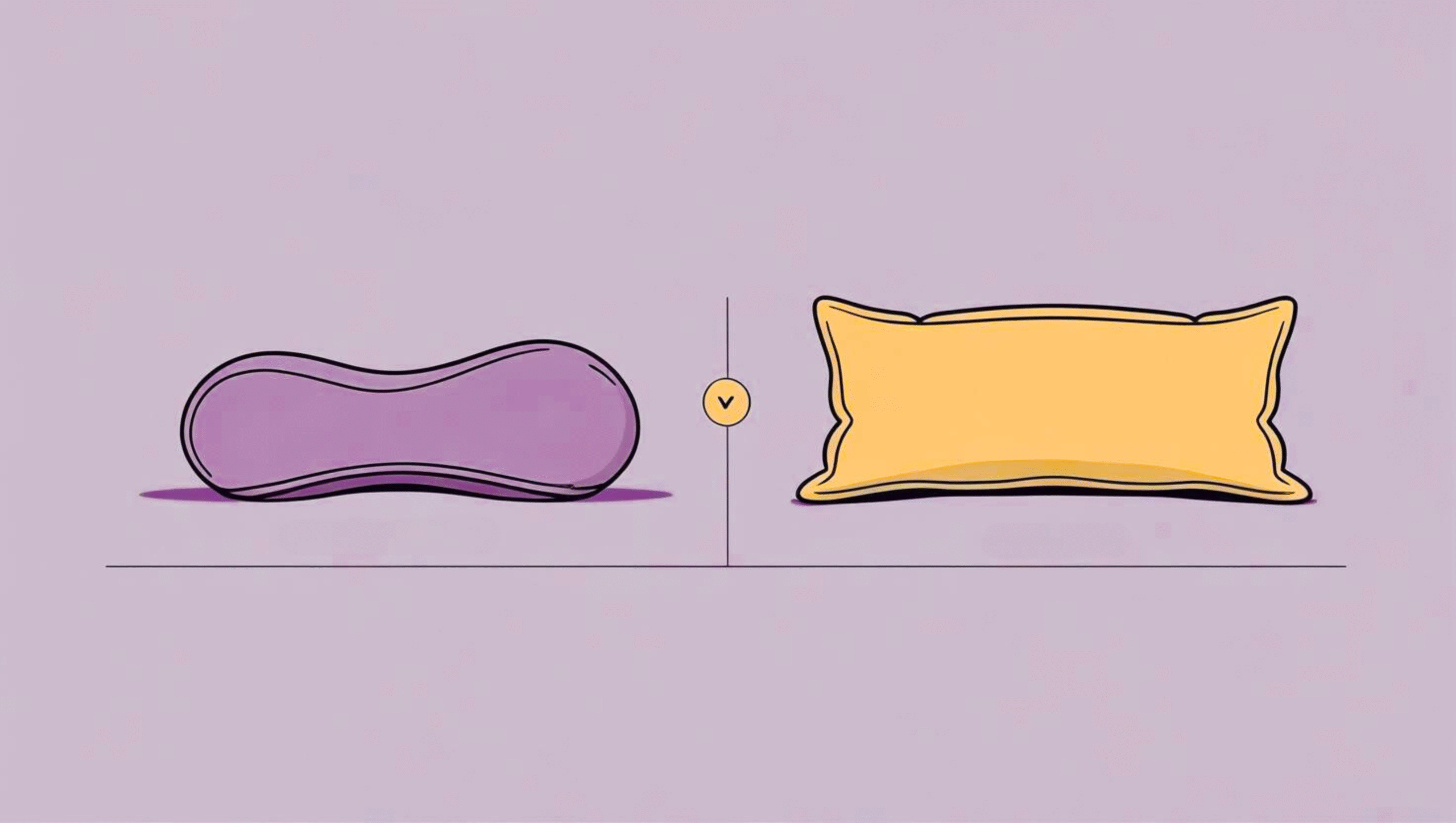You wake up, stretch your neck, and there it is again: the soreness that starts at the back of your skull and seeps into your shoulders. It’s not caused by stress or television. More often than not, the real offender is your pillow.
For everyone above 30, waking up stiff or unrefreshed is more than a nuisance. It’s an early warning sign that your spine is not properly supported. The older you get, the more sensitive your body is to poor sleeping posture, and what you sleep on is just as significant as how long you sleep.
What many do not know is that all pillows are not created equal. A flat pillow may be comfortable to lie on, but it tends to come up short in maintaining the alignment of the neck and spine properly, especially among the elderly. A contour pillow, however, supports the natural shape of the neck and keeps everything aligned throughout the night.
This guide is comparing flat and contour pillows based on expert recommendations and scientific realities so that you may select the most appropriate one for long-term comfort, improved sleeping posture, and age-old health.
Why Should You Care About Pillow Choice as You Age?
Beyond the age of 30, the body naturally begins to undergo structural changes. The spinal discs dry out and lose their elasticity, reducing their ability to absorb shock and cushion vertebrae. This places even greater importance on maintaining proper alignment when sleeping. Sleep is supposed to be restorative, but when posture is sacrificed, the spine is unable to relax or regenerate.
A badly made pillow will contort the neck into abnormal angles. It forces muscles and ligaments to work overtime at night, leading to micro-strains. They build up over time, and this can lead to stiffness, pain, or even long-term cervical spine disease. Having a supportive pillow is necessary not just for improved sleep but also for avoiding posture degradation because of age and musculoskeletal discomfort [1].
Common Sleep-Related Issues in Aging Adults
Neck stiffness and morning pain
Most adults above 30 years suffer from morning pain or stiffness in the shoulders and neck. This is normally a result of inadequate cervical support at night. If the neck cannot be maintained in its normal curve, contracted muscles will stay for hours, causing morning ache. In some severe cases, it might interfere with range of motion throughout the day as well as influence mood and concentration.
Poor spinal alignment and its long-term effects
Misalignment at night may exacerbate nothing, but with the passage of time, the consequences accumulate. Placing the head in a position that is too high, too low, or un-supported can lead to uneven loading of the spine. Further on, this can culminate in poor posture, nerve compression, and chronic neck or back pain. It has been seen that long-term misalignment raises the risk for musculoskeletal disorders and hampers physical recovery [2].
Even though you now sleep pain-free, neglecting pillow quality can still bring about avoidable problems in the future. An orthopedic pillow is a cheap yet effective solution to assist you in safeguarding spinal health and staying comfortable throughout the years.
What Is a Contour Pillow?
Design and Purpose
Contour pillows also have an ergonomic shape that replicates the natural shapes of the head, neck, and shoulders. The most popular design has a bit of a dip in the middle where the head is placed and raised sides that support the neck. This design promotes the alignment of the cervical spine when sleeping. By maintaining the neck in a neutral position, contour pillows avoid unnecessary stress on muscles and joints. Standard pillows, on the other hand, become flat or develop lumps with time. Contour pillows, instead, stay in their shape and provide stable support throughout the night.
Materials Used (Memory Foam, Latex, Gel)
Contour pillows are typically made with responsive materials such as memory foam, latex, or gel-infused foam. Each of these has its own advantages. Memory foam molds closely to the body of the user, providing individualized support and adequate pressure relief. It also reduces motion transfer, which is beneficial for light sleepers. Latex is springier and better ventilated, ideal for warm environments. Gel-infused varieties have a cooling ingredient, ideal for users who overheat during sleep. All these materials are resistant and they maintain structural stability over time, which is essential for consistent support of the neck [3].
Benefits for Aging Adults
Supports natural neck curvature
As one gets older, ligaments and muscles that stabilize the cervical spine lose flexibility and weaken. A contour pillow supports the neck in its natural C-shaped curve while sleeping. This minimizes muscle tension, promotes improved posture over time, and may avoid reliance on painkillers or corrective therapy.
Reduces snoring and improves airway alignment
When the neck and head are in the correct position, the airways will stay open, and this can minimize snoring and encourage deeper, disturbance-free sleep. This is especially helpful for elderly individuals or people with mild obstructive sleep apnea because even a minor position change can impact airflow [4].
What Is a Flat Pillow?
Flat pillows are a basic rectangular shape with a flat surface. They are typically filled with polyester fiberfill, down, feathers, or cotton. They provide a soft and comfortable feeling but fail to mold to the head or neck shape. The basic structure is adequate for general comfort but does not provide the adaptive support required in spinal therapy. Various models are created with various softness or loft options, but even they are not ergonomic-specific with their flat surface.
When Flat Pillows Work Well
Flat pillows will be effective in some situations. They will suit children or young adults with more supple spines and less musculoskeletal disorder. They are also suitable for stomach sleepers, who usually don’t require much pillow thickness to prevent neck hyperextension. For such situations, employing a flat pillow will minimize stress and maintain the spine almost neutral.
Drawbacks of Flat Pillows for Adults 30+
For adults over the age of 30 and particularly those with early cervical degeneration or poor posture, flat pillows may cause more harm than benefit. Their flat design possesses less contouring, which can result in forward head posture during sleep. This tension causes the muscles covering the cervical spine to be kept on their toes, blaming them for persistent pain and low-quality sleep. Research has indicated that flat pillows do not provide the proper alignment of the neck and actually exacerbate symptoms of those with pre-existing cervical problems [5].
What Are the Key Differences Between Contour and Flat Pillows?
Contour pillows support the natural curve of the neck, providing improved cervical alignment and pressure relief. Flat pillows provide none of this unique support, positioning the spine for stress.
Comfort for Side, Back, and Stomach Sleepers
Contour pillows are especially beneficial to side and back sleepers, to whom proper neck elevation is crucial. Flat pillows may still be appropriate to stomach sleepers but have little use to anyone else.
Doctor and Physiotherapist Recommendations
When doctors recommend contour pillows
Doctors and medical professionals usually prescribe contour pillows to the neck-pain, cervical spondylosis, or posture-related disorders of their patients. Physiotherapists also suggest ergonomic sleeping accommodations to improve rehabilitation outcomes [6].
When flat pillows may still be suitable
Doctors may still suggest flat pillows for specific sleep positions like stomach sleeping or for individuals with unique medical requirements.
What Do Experts Say About the Right Pillow Choice?
Insights from Physiotherapists
Physiotherapists emphasize that spinal alignment during sleep is crucial for long-term musculoskeletal health. Ergonomic pillows, especially contour models, help reduce tension and promote natural positioning.
Chiropractic View on Pillow Choice
Chiropractors support the use of contour pillows for maintaining healthy cervical curves. They argue that without this support, the risk of subluxation, nerve irritation, and postural imbalances increases [7].
Studies Linking Pillow Use with Sleep Quality and Pain Relief
Research from the Journal of Physical Therapy Science found that using cervical contour pillows led to significant reductions in neck pain and improvements in sleep quality among older adults [8]. Another study in the Journal of Manipulative and Physiological Therapeutics confirmed that orthopedic pillows improve sleep-related outcomes for patients with chronic cervical pain [9].
How Do You Choose the Right Pillow for Your Needs?
1. Age-Related Considerations
After the age of 30, natural wear and tear on the spine begins to show. A supportive pillow that aligns the spine can mitigate age-related degeneration and improve sleep recovery.
2. Health Conditions to Factor In (e.g., arthritis, cervical spondylosis)
Those with arthritis or cervical spondylosis benefit greatly from the consistent support and pressure relief that contour pillows provide. Flat pillows typically worsen symptoms due to insufficient elevation and alignment.
3. How to Transition to a Contour Pillow
Start by using the contour pillow for short naps or partial nights to allow your muscles to adjust. Gradually increase use until your body fully adapts. Most users report full adaptation within one to two weeks.
How Does Betterhood Support Aging-Well Through Sleep?
At betterhood, we believe wellness starts from the ground up, and that includes the surface you rest on every night. Sleep is not just about duration it’s about quality, posture, and restoration. Our contour cervical pillows are developed in close collaboration with physiotherapists, orthopedic experts, and material scientists to ensure every pillow delivers maximum spinal support, targeted pressure relief, and all-night comfort. By aligning the neck and shoulders properly, our designs help reduce the physical stress that accelerates signs of aging and disrupts restful sleep.
We view sleep health as a foundational aspect of longevity. Just as exercise and nutrition are essential to aging well, so is optimizing the body’s recovery process during sleep. That’s why our pillows are engineered not just to feel good, but to support musculoskeletal health and long-term wellness.
Empowering Adults with Practical Sleep Solutions
betterhood is committed to providing solutions that are both scientifically sound and practically useful. We design our products to empower users to take proactive steps in their health journey no matter what stage they are in. If you’ve just started experiencing mild stiffness or are already managing chronic neck and back pain, our pillows are made to meet your needs.
Each product comes with simple usage guides and evidence-based recommendations so that you can transition to better sleep habits confidently. Our goal is to help you move from reactive health fixes to preventive care starting with something as simple and powerful as your pillow choice.
Frequently Asked Questions:
1. Are contour pillows better for neck pain than flat pillows
Yes, contour pillows provide targeted neck support that helps alleviate pressure and maintain natural alignment, which flat pillows often cannot offer [10].
2. Can flat pillows worsen chronic pain or poor posture?
Flat pillows may fail to provide adequate support, which can worsen cervical spine misalignment and related pain over time.
3. Are contour pillows uncomfortable at first?
Some users experience a short adjustment period, but most find significant relief within a few nights to a week.
4. Can using the wrong pillow accelerate signs of aging?
Improper sleep posture caused by the wrong pillow can contribute to musculoskeletal issues, stiffness, and reduced mobility, which are often associated with aging.
5. How do I know if my pillow is affecting my sleep quality?
If you wake up with neck pain, stiffness, or headaches, or if you toss and turn often, your pillow may be contributing to poor sleep posture.
References
- https://www.ncbi.nlm.nih.gov/pmc/articles/PMC6741342/
- https://www.ncbi.nlm.nih.gov/pmc/articles/PMC7263543/
- https://www.sciencedirect.com/science/article/abs/pii/S0014488617300339
- https://www.sleepfoundation.org/snoring/best-pillows-for-snoring
- https://pubmed.ncbi.nlm.nih.gov/30644363/
- https://www.ncbi.nlm.nih.gov/pmc/articles/PMC8955892/
- https://www.chiro.org/LINKS/ABSTRACTS/The_Use_of_Pillows.htm
- https://www.jstage.jst.go.jp/article/jpts/26/12/26_jpts-2014-274/_article
- https://www.jmptonline.org/article/S0161-4754(14)00145-6/fulltext
- https://pubmed.ncbi.nlm.nih.gov/31161408/



















